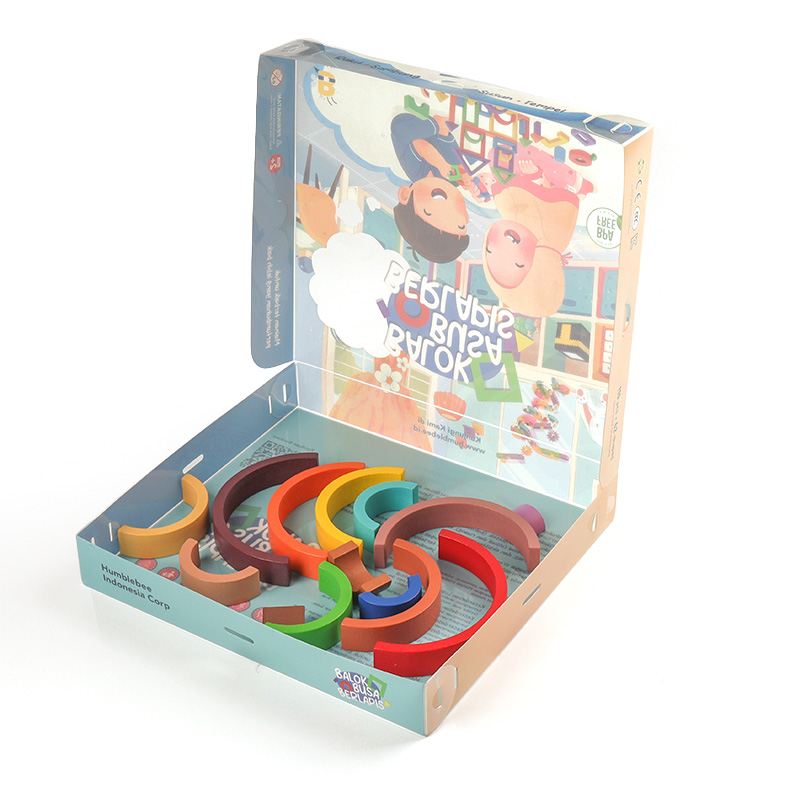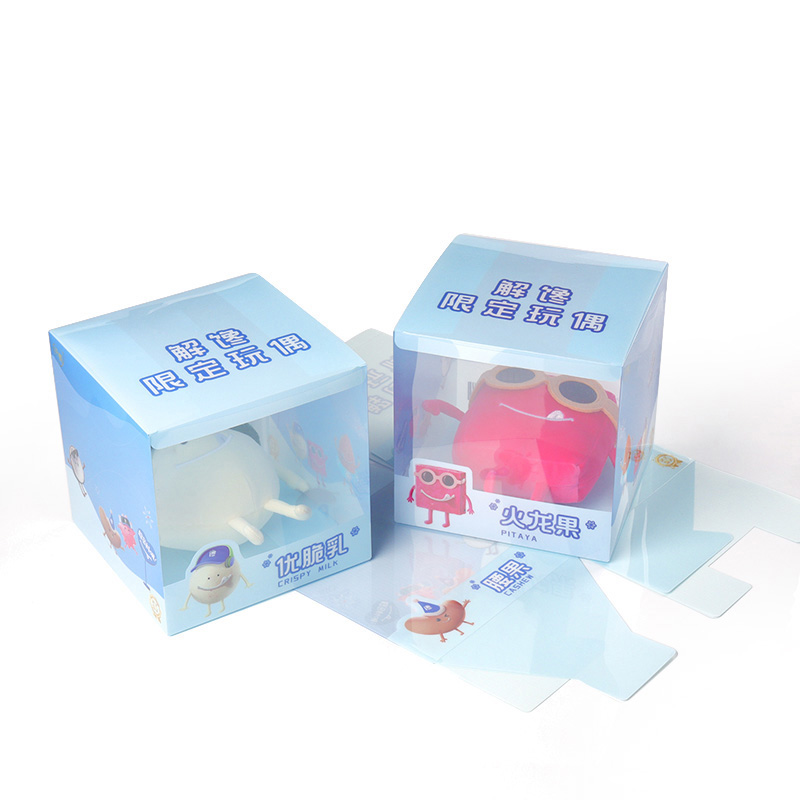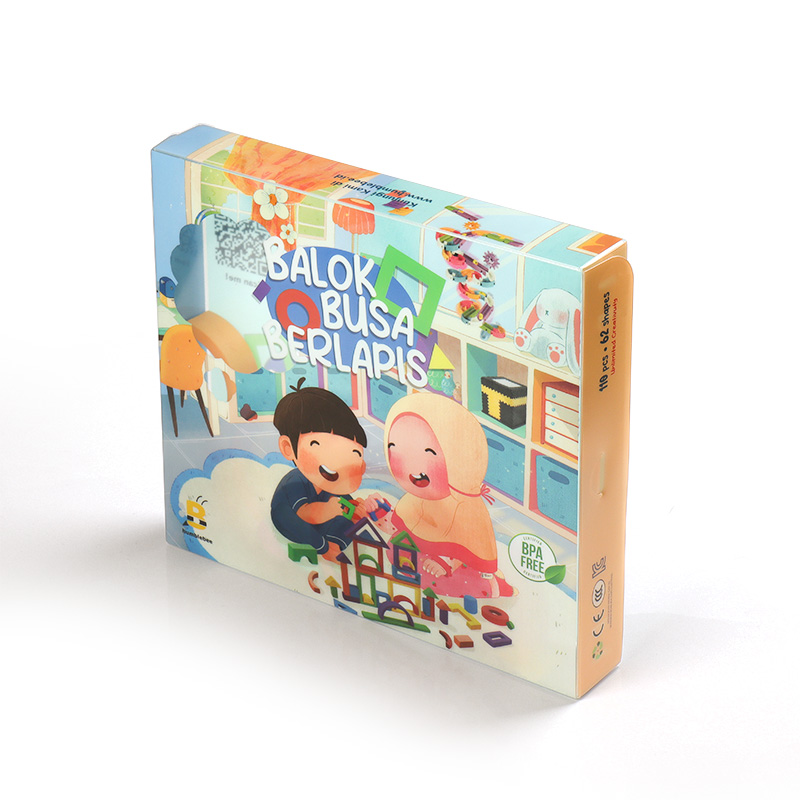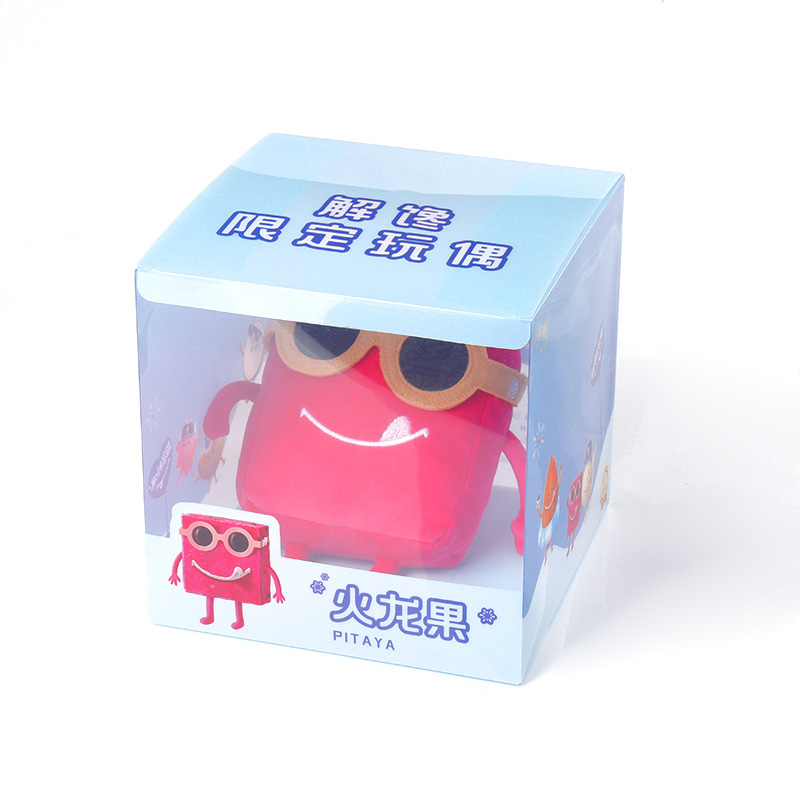はじめに
In the dynamic world of toys, packaging plays a crucial role in attracting attention and conveying information. The plastic toy packaging box is the first point of contact between the product and the consumer. Let’s take a deep dive into all aspects of プラスチック玩具包装, from types and benefits to environmental concerns and future trends.

Types of Plastic Toy Boxes
- Blister Packaging: Blister packaging is a type of lightweight, clear plastic packaging often used to protect toys and other products. Blister packaging can provide shock-proof and dust-proof protection, keeping products intact during transportation and storage.
- Window box: A window box is a packaging box with a transparent window that allows consumers to see the product clearly. This type of packaging box is often used to showcase the appearance and functionality of a toy while providing protection.
- Combined packaging: Combined packaging boxes usually consist of multiple parts, including the lid, chassis and sides. This kind of packaging box provides more display and protection space and is suitable for toys that require extra storage and display space.
- Plug-in packaging: A plug-in packaging box is a plastic box with multiple slots into which the toy can be inserted and secured. This type of box is ideal for toy sets or multiple-unit packaging where neatness and consistency are required.
- Closed Packaging: A closed packaging box is a completely enclosed plastic box, usually with tear lines or cut lines to allow consumers to open the box. This type of box is suitable for toys that need to be kept intact and in good condition, as well as toys that have small parts or sharp edges that need to be kept away from children.
- Portable packaging: A portable box is a design with a handle or handle that allows consumers to carry toys conveniently. This kind of packaging box is suitable for portable toys, such as travel toys, jigsaw puzzles, etc.
- Gift-style packaging: Gift-style packaging boxes usually have an attractive appearance and decoration to attract consumers and increase the product's appeal. This type of packaging box is suitable for toys as gifts and can also enhance the brand image and brand value of the product.
Advantages of plastic toy packaging boxes
Plastic toy packaging boxes indeed have many advantages, which not only protect the toys but also provide consumers with a good shopping experience. Here are some of the key benefits of plastic toy packaging boxes:
- Durability and protection: Plastic toy boxes are generally more durable than cardboard or other non-plastic materials. This durability allows plastic packaging to provide adequate protection for the toy during transportation, preventing damage from shock, pressure, or accidental drops. At the same time, plastic packaging can also prevent toys from being contaminated by dust and dirt on store shelves, keeping toys in new condition.
- Transparency: Many plastic toy packaging boxes are transparent, which allows consumers to clearly see the actual appearance and shape of the toy without opening the package. This preview feature not only allows consumers to more accurately understand the appearance and functionality of the product but also increases purchase certainty. Consumers can more accurately judge whether they like the look and design of a toy, reducing the risk of purchasing errors.
- Enhanced shopping experience: Due to the transparency of plastic packaging boxes, consumers are able to see the actual appearance and functions of the toys when purchasing them, which increases the fun and satisfaction of shopping. This experience can enhance consumers' interest in and attraction to the product, thus boosting sales.
- Convenient to carry: Some plastic toy packaging boxes are designed to be lightweight and compact and have handles to facilitate carrying by consumers. This portability makes plastic packaging boxes an ideal choice for portable toys, such as travel toys and puzzles.
- Reusable: Unlike disposable packaging, plastic toy boxes can be reused. If consumers purchase plastic packaging boxes with transparent features, they can reuse these boxes when buying new toys to save resources and reduce waste generation.
In summary, the advantages of plastic toy boxes include their durability and protection, transparency, enhanced shopping experience, portability, and reusability. These advantages provide consumers with a good shopping experience and protect the safety of toys during transport and storage.
Design and customization options
When designing plastic toy packaging, manufacturers really have unlimited creativity and can customize the box to reflect the essence and characteristics of the toy. The following are some design considerations:
- Toy theme and style: The packaging design should be consistent with the theme and style of the toy. For example, if the toy is a cartoon character or a specific character, the packaging design can incorporate corresponding elements and images to showcase the character's characteristics and personality.
- Bright colors: Using bright colors can attract consumers’ attention and improve the visibility of the product. When it comes to children's toys, choose bright and contrasting color combinations to spark interest in your children. Meanwhile, for adult toys, such as collectibles or premium toys, using more low-key and pastel colors can reflect the quality and sophistication of the product.
- Engaging graphics: Engaging graphics and patterns can make packaging more appealing. These graphics can be abstract patterns, cartoon characters, animated scenes, or specific themed elements. Through exquisite illustrations and graphic design, consumers' curiosity and interest in the toys can be enhanced.
- Customized design: Manufacturers can provide customized packaging design services and customize them according to the customer's specific requirements. This customization service can include unique color combinations, specific graphics and labeling, etc. to help customers create a unique brand image and product identity.
- Sustainability and Eco-Friendly: When designing plastic toy packaging, it is important to consider the use of sustainable and eco-friendly materials and designs. This can be achieved by choosing recyclable materials, optimizing packaging structures to reduce material usage, using biodegradable plastics, etc. Additionally, low-carbon production methods may be considered to reduce environmental impact.
By considering and applying these design elements, manufacturers can create unique and eye-catching plastic toy packaging that improves brand image and consumer recognition. At the same time, this creative packaging can also stimulate consumers' desire to purchase and increase the market competitiveness of the product.

Environmental Problems and Solutions
Although plastic packaging causes environmental concerns, the industry is actively exploring sustainable solutions. Biodegradable plastics and recycling initiatives are booming with the aim of reducing the ecological impact of plastic toy packaging.
Impact on brand
Packaging is your silent brand ambassador. The design, color scheme, and overall aesthetics influence how consumers perceive a brand. A well-thought-out plastic toy packaging box can significantly improve your brand image and recognition.
Cost-effectiveness and efficiency
In addition to being aesthetically pleasing, plastic toy packaging can be a cost-effective solution for manufacturers. The production efficiency and lightweight properties of plastic help reduce shipping costs, making it an economically viable option.
Innovation in Plastic Toy Packing
The industry continues to evolve, launching innovative packaging solutions. From interactive packaging with augmented reality features to sustainable materials, manufacturers are pushing the boundaries of traditional packaging specifications.
Consumer Safety and Regulation
Ensuring the safety of consumers, especially children, is of utmost importance. The production of plastic toy packaging is strictly regulated to protect against potential hazards. At jiangxin, we adhere to these standards to ensure the well-being of our users.
Challenges faced by manufacturers
While plastic toy packaging offers numerous advantages, manufacturers still face challenges such as rising material costs and the need to continually innovate to remain competitive. Addressing these challenges is critical to the continued success of the industry.
Tips for selecting the right packaging
Choosing the right plastic toy packaging is indeed crucial for both manufacturers and consumers. The following are some factors that influence the decision-making process:
- Product fragility: For some more fragile toys, such as delicate models or fragile ornaments, a good plastic packaging can provide the necessary protection to prevent the toys from being damaged during transportation or storage. In this case, packaging durability and protection are key factors in selection.
- Marketing Objectives: Packaging is not only a means of protecting the product but also a marketing tool. An attractive packaging can increase the attractiveness of the product and increase consumers' interest and desire to buy. Manufacturers can choose the colors, graphics and design of packaging based on their marketing goals to appeal to specific groups of consumers.
- Environmental considerations: As concern about environmental issues continues to grow, it is becoming increasingly important to choose environmentally friendly plastic toy packaging. This can be achieved by choosing recyclable or biodegradable plastic materials. In addition, reducing unnecessary packaging and optimizing packaging design to reduce waste are also environmental factors that manufacturers should take into consideration.
- Cost-effectiveness: In addition to the above factors, cost is also an important factor to consider when selecting plastic toy packaging. Manufacturers need to weigh the cost of packaging versus the overall price and quality of the product. At the same time, consumers also need to consider the product's cost-effectiveness when deciding whether to purchase it.
To sum up, manufacturers and consumers need to consider multiple factors when choosing plastic toy packaging, including the fragility of the product, marketing goals, environmental protection, and cost-effectiveness. By taking these factors into consideration, they can make informed decisions and choose the right plastic toy packaging to protect products, attract consumers and achieve sustainability.
Case studies
Examining successful packaging strategies can offer valuable insights. Jiangxin has adopted the following strategies to increase product attractiveness and reduce purchase risk:
- Innovative design: Jiangxin invested in the design team and developed a range of unique and attractive packaging designs. Not only do these designs protect the toys from damage, but they also attract consumers' attention through the use of bright colors and engaging graphics.
- Transparency: Jiangxin understands that many consumers want to see the actual appearance and function of the toys when purchasing them. Therefore, they developed transparent packaging boxes so that consumers could clearly see the shape and color of the toy.
- Sustainability: Faced with increasing environmental awareness, Jiangxin decided to adopt a sustainable packaging strategy. They began to use recyclable plastic materials and optimized packaging design to reduce the amount of material used. Additionally, they have introduced biodegradable plastic options to meet customers’ environmentally friendly needs.
- Customized services: In order to meet customers' individual needs, Jiangxin provides customized packaging services. They can customize color combinations, graphic designs, and labels according to customers' requirements to help customers create a unique brand image.
- Product safety: Jiangxin attaches great importance to product safety. Their packaging design ensures that toys will not be damaged or contaminated during transportation and storage. In addition, they provide detailed safety certification and testing reports to enhance consumers’ trust in the products
Future trends in toy packaging
The development of toy packaging in the future is indeed exciting. Here are some key trends that are critical for industry players to understand:
Further adoption of sustainable materials: With the growing awareness of environmental protection, toy packaging will pay more attention to the use of sustainable materials in the future. This could include the use of recyclable or biodegradable plastic materials, as well as more paper-based packaging instead of traditional plastic packaging. Industry players need to pay attention to this trend and look for sustainable packaging solutions that match consumer and market demands.
- The importance of technology integration in packaging design: As technology continues to develop, more technologies will be integrated into toy packaging design. This might include using augmented reality (AR) technology to make packaging an interactive experience or using Internet of Things (IoT) technology to better track and manage inventory. These technologies not only increase the attractiveness of packaging but also increase efficiency and reduce costs.
- Personalization and customization: Toy packaging will pay more attention to personalization and customization in the future. Manufacturers may offer more customization services, including designing unique packaging based on consumers' preferences and needs. In addition, through the use of big data and artificial intelligence (AI) technology, manufacturers can better understand consumers' purchasing behaviors and preferences, thereby providing more personalized products and services.
- Enhanced user experience: packaging does more than protect and display products; it also enhances the user experience. Through clever design and innovative materials, manufacturers can create engaging packaging that consumers enjoy during the process of opening the package. In addition, interactive packaging can also attract consumers' attention and increase the time they spend interacting with the product.
- Safety and Compliance: As requirements for product safety continue to increase, toy packaging must also comply with relevant safety standards and regulations. Industry players need to be aware of the latest safety standards and regulations and ensure that their product packaging complies with these requirements. At the same time, they also need to continue to improve and innovate to improve the safety and compliance of their products.
In short, the development of toy packaging in the future will be full of opportunities and challenges. Industry players need to pay close attention to these trends and flexibly adapt their strategies and products to meet the needs of the market. At the same time, they need to continue to innovate, research and develop to meet consumer expectations and promote the development of the entire industry.

conclusion
To summarize, plastic toy boxes are more than just containers; they are key players in the marketing and protection of toys. Balancing creativity, sustainability and compliance is the way forward for manufacturers seeking lasting success in the dynamic toy industry.
よくあるご質問
Are plastic toy packaging boxes eco-friendly?
Explore environmental impacts and sustainable development efforts.
Which design elements of toy packaging attract consumers?
Discuss visual aspects that influence consumer decision-making.
How do regulations guarantee the safety of plastic toy packaging?
Articulate existing standards to protect consumers, especially children.
Could innovative packaging help boost sales?
Examining correlations between packaging innovation and consumer engagement
Where can I find high-quality plastic toy packaging for my product?
Provide guidance on sourcing reliable and appropriate packaging solutions.
関連商品
























